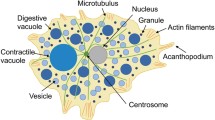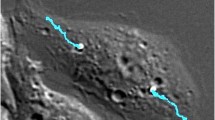Summary
The movement of latex beads over pinocytotic pseudopodia produced byAmoeba proteus was recorded in the presence of 117.65 mM EGTA as an inducer of pinocytosis. The results show that all particles flow in the direction of pseudopodial growth, with a slightly higher velocity than the advancing frontal edge. This means that markers are removed from the base of a pinocytotic pseudopodium and gradually approach the pseudopodium tip. Two particles on the surface of the same pseudopodium can move at the same rate or differ slightly in the velocity of their forward flow. A bead can move even if another blocks the channel orifice. Retrograde particle movement has never been observed. Whether all latex spheres bound to pinocytotic pseudopodia flow with the laterally mobile plasma membrane fraction, which slides over submembranous contractile layer, or whether the whole cortical complex, the actin network and the plasma membrane, move together towards the invagination site is discussed.
Similar content being viewed by others
References
Chapman-Andresen C (1962) Studies on pinocytosis in amoebae. CR Lab Carlsberg 33: 123–155
Christofidou-Solomidou M, Brix K, Stockem W (1989) Induced pinocytosis and cytoskeletal organization inAmoeba proteus — a combined fluorescence and electron microscopic study. Eur J Protistol 24: 336–345
Czarska L, Grębecki A (1966) Membrane folding and plasma-membrane ratio in the movement and shape transformation inAmoeba proteus. Acta Protozool 4: 201–239
De Petris S (1977) Distribution and mobility of plasma membrane components on lymphocytes. In: Poste G, Nicolson GL (eds) Cell surface reviews. North-Holland, Amsterdam, pp 643–728
Grębecka L, Kłopocka W (1985) Relationship between the surface distribution of membrane reserves and the polarity of pinocytosis inAmoeba proteus. Protistologica 21: 207–213
Grębecki A (1986) Two-directional pattern of movements on the cell surface ofAmoeba proteus. J Cell Sci 83: 23–35
— (1987) Velocity distribution of the anterograde and retrograde transport of extracellular particles byAmoeba proteus. Protoplasma 141: 126–134
— (1988) Bidirectional transport of extracellular material by the cell surface of locomotingSaccamoeba limax. Arch Protistenk 136: 139–151
— (1990) Dynamics of the contractile system in the pseudopodial tips of normally locomoting amoebae, demonstrated in vivo by video-enhancement. Protoplasma 154: 98–111
— (1991) Participation of the contractile system in endocytosis demonstrated in vivo by video-enhancement in heat pretreated amoebae. Protoplasma 160: 144–158
Haberey M, Stockem W (1973) Induced endocytosis inAmoeba proteus. In: De Puytorac P, Grain I (eds) Actualites protozoologiques 1. Universite de Clermont, 4th International Congress of Protozoology, Clermont-Ferrand, p 267
Holter H (1965) Physiologie der Pinozytose bei Amöben. In: Wohlfarth-Bottermann KE (ed) Sekretion und Exkretion. Springer, Berlin Heidelberg New York, pp 119–146
Klein HP, Stockem W (1979) Pinocytosis and locomotion of amoeba. XII. Dynamics and motive force generation during induced pinocytosis. Cell Tissue Res 197: 263–279
—, Köster B, Stockem W (1988) Pinocytosis and locomotion of amoebae XVII. Different morphodynamic forms of endocytosis and microfilament organization inAmoeba proteus. Protoplasma [Suppl 2]: 76–87
Kłopocka W, Grębecka L (1985) Effects of bivalent cations on the initiation of Na-induced pinocytosis inAmoeba proteus. Protoplasma 126: 207–214
Maeda Y, Kawamoto T (1986) Pinocytosis inDictyostelium discoideum. A possible implication of cytoskeletal actin for pinocytotic activity. Exp Cell Res 164: 516–526
Mast SO (1926) Structure, movement, locomotion, and stimulation in amoeba. J Morphol Physiol 41: 348–425
Singer SJ, Nicolson GL (1972) The fluid mosaic model of the structure of cell membranes. Science 175: 720–731
Stockem W (1972) Membrane turnover during locomotion ofAmoeba proteus. Acta Protozool 11: 83–93
—, Hoffmann HU, Gruber B (1983) Dynamics of the cytoskeleton inAmoeba proteus. Redistribution of microinjected fluoresceinlabelled actin during locomotion, immobilization, and phagocytosis. Cell Tissue Res 232: 79–96
Taylor DL, Blinles JR, Reynolds G (1980) Contractile basis of ameboid movement. VIII. Aequorin luminescence during ameboid movement, endocytosis and capping. J Cell Biol 86: 599–607
Wolpert L, O'Neill CH (1962) Dynamics of the membrane ofAmoeba proteus studied with labelled specific antibody. Nature 196: 1261–1266
Author information
Authors and Affiliations
Rights and permissions
About this article
Cite this article
Kłopocka, W., Kołodziejczyk, J., Pomorski, P. et al. Movement of surface markers along the pinocytotic pseudopodia ofAmoeba proteus . Protoplasma 178, 28–33 (1994). https://doi.org/10.1007/BF01404118
Received:
Accepted:
Issue Date:
DOI: https://doi.org/10.1007/BF01404118




